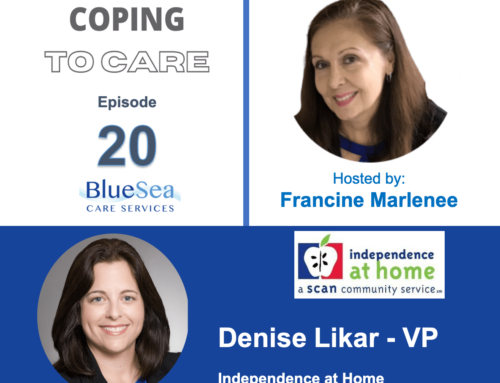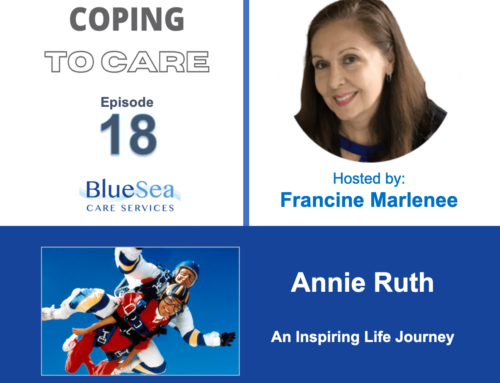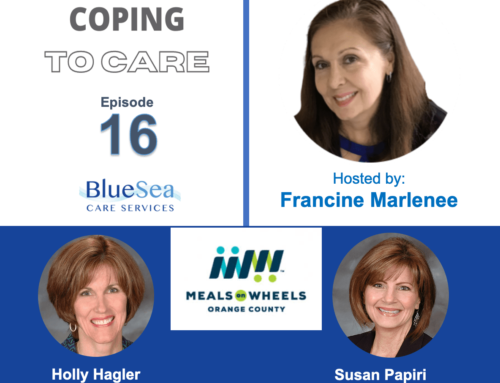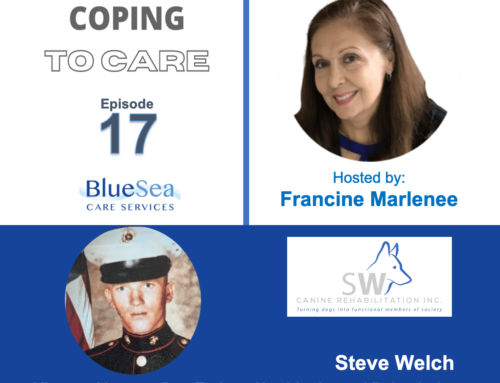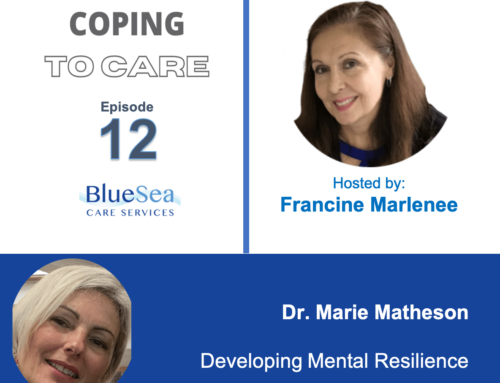Art to Wellness® is highlighted by the benefits of the arts for cognitive care among seniors and their families. It supports the many layers of receiving support for mental and emotional well-being, all of which assist in balancing overall wellness.
This week, licensed art therapist, Heidi Landis, speaks to us about the therapeutic benefits of the arts and her experience with assisting seniors and their families with finding their creativity and healing from trauma through the power of the arts.
Listen to our Coping to Care podcast and get insights on how much the arts can assist you with care.
Heidi Landis is a New York licensed creative arts therapist, registered drama therapist, group psychotherapist, and practitioner of psychodrama. She uses psychotherapist techniques and drama therapy to assist with personal empowerment, traumatic healing, and emotional to physical integration.
Heidi notes that the creative art therapies, especially drama, is a way to access the different experiences we have that we need to embody. She notes that we are often cut off from experiencing things in our body because of stress, “being in our head,” or not accepting the processes we need to move through the experience completely.
She states that the truth is that our experience, especially trauma, lives in the body. Psychodrama gives us a model to connect in new ways.
Drama therapy is the intentional use of using drama and theater for therapy. It’s active, experiential, and works with an individual’s imagination to move into reality from creativity to methodologies of the psyche that need to be integrated.
Psychodrama differs by its model but tends to work slightly more with a personal story and bringing that to life while drama therapy works metaphorically.
The Power of Imagination and Metaphor
Heidi notes that, even if we aren’t conscious about our experiences, we are always working and thinking in metaphor. This gives us an opportunity to explore things safely.
If someone comes into a room with psychotherapy, it’s often difficult to speak about what has happened to them. When using metaphor, it creates a parallel process and to have some safety with processing trauma.
Heidi notes that “me – not me” is a part of the drama, especially when you are a character. However, a character always has a part of you in them. This gives someone in therapy some breadth to identify the elements that are real and others that are creative.
As someone works with drama therapy, the not-me becomes closer and is a part of the “me” or the trauma.
Thinking About Roles for Healing
What are the roles in our lives? Heidi explains that the more we understand about different roles in our lives, the healthier we become. If can state things such as being a mother and a daughter, a therapist, and a therapy student, a nice person, and a mean person, that it begins to integrate the different characters that are a part of who we are.
When someone is “stuck” or in a place of trauma, it is because they are stuck in a role. They identify one part of themselves, such as being a “bad kid” or “the person no one needs.” This story creates a core concept of expanding our role repertoire. When we do this in drama therapy, there are no consequences, but we are able to integrate the parts of us that we wouldn’t look at who we are.
With the safe expression of roles, experiences, and feelings, there are fewer chances of re-traumatizing. This is because someone is able to separate from the story until they can integrate it into a safe space and into a place of healing.
Building Your Creativity
“Without imagination, we can’t go forward.”
Heidi Landis’ quote above highlights how the imagination and creativity are central to processing the deeper parts of ourselves that we can’t integrate into other ways. With the use of imagination, those who have been through traumatic experiences are able to express and experience what they are “stuck” in or couldn’t process any other way.
She states that it’s not just creativity, but it’s bringing imagination into reality. For instance, if you wanted to go to college, you had to imagine it before you had to do it. When there is a life experience or trauma, it takes away that experience because it’s not safe.
We are innately imaginative and creative beings. Getting back in touch with that breaks through the trauma and allows you to move forward with your imagination.
Telling Your Own Story
Seniors will often state that they “can’t change” or not move into growth or a different cycle within their lives.
Heidi states that the roles of seniors need to change. When you have access to more roles it assists you. It’s also possible to retire your role if it no longer serves you. There are infinite possibilities of the role you want to be in and how you want to create this.
At any age, you can create the role that you desire in your life. It’s also possible to have the power to retire a role. You no longer need that role. Thank it, notice that it has served its purpose, but it doesn’t need to take over.
This way, you can make space for something new, especially for seniors.
Jay Moreno, the founder of psychodrama, stated that creativity and spontenaity are important to define. Most will become intimidated by these concepts. Changing the definition of spontaneity to a new response to an old situation or an adequate response to a new situation assists with changing and creating new roles.
What response are you changing to feeling that you “can’t change” or do something new?
Connect the imagination to the roles you want to change, even if it’s small, to open new ways of opening and playing, connecting, and growing.
Seniors and Self-Esteem
Feeling like you can’t get back to happiness, self-acceptance, and doing what you need to?
Heidi has one word to assist with lost self-esteem – play.
Play by moving your body and see what changes.
Play with theater games that have an intention so you can connect with others and with the parts of you that need to open up.
Play by working with others in groups for relationships and understand that the group is it’s own therapeutic agent. The connections and interactions through play will open up and create playfulness, imagination, and creativity.
Heidi uses drama therapy with a strength-based position. This is what is already there so you can “re-story.”
She states that when you re-story, you recognize that there are more stories to be told. There is a power to create new paths. For seniors, who feel their path is ending, she states that this is challenging. Maybe there is a new path that is beginning or that can offshoot.
This doesn’t mean getting rid of old stories but recognizing how to transform into a new story and to write your own story and what you really need when working with art therapy for seniors in SoCal.
You get to write your own story.

Creative Tips for Art and It’s Therapeutic Benefits
In conjunction with Painting with Mom, we asked Heidi about her incorporation of arts with those that may not be as “artistic.”
Heidi noted that the most important part of working with art therapy is to connect with individual creativity. What she knows is that she can’t lead a creative art therapy group or process unless she’s engaged with her own creativity.
Every individual who is participating or hosting an art style class should be connected to their own creativity while letting go of the expectations of what should or shouldn’t happen.
Be open to what is happening in the room. Throw your plans out the window and be present in the moment. This is where the true, raw creativity of every individual is.
Trust your creativity and spontaneity to be in the moment.
What Can You Do To Re-Invent Yourself?
“Human beings are by nature actors who cannot become something until they have first pretended to be it.” W.H. Audin
Heidi notes that stepping into something new as a metaphor is important, especially later in your life. A strength-based perspective, filled with creativity, allows you to be in the world with new possibilities.
If you feel stuck, work with creative play and think about and imagine how you can get out of the situation. When you enter into a drama scenario, you are playing inside it and it is a border from reality.
In that play space, anything can happen. The goal is to find things about yourself, without consequence, to explore your role. When you begin to internalize the play, imagine what is new, create new connections, develop relationships, then it becomes possible.
After this, the therapeutic space becomes a reality where you can reinvent yourself.
The Process of Creativity
The process of creativity is more important than the result. Heidi’s approach is to look at the experiences. Even though there is a product, it is not as important as the imaginative process they had.
Imagination is a visceral way of challenging our emotions here and now. Heidi notes that we can be anything. When we take on those roles, we never stop learning and growing.
It doesn’t matter how old we are, there are still parts that are still learning and growing, but more wisdom that is available from seniors when they connect to the creative self.
What Heidi also notes is that creativity and anxiety are in correlation to each other. When there are higher levels of anxiety and we go into fight or flight, it blocks imagination. When working with imagination instead, it creates new possibilities. That process “unsticks” the anxiety, connects to creativity, allows you to imagine something new, and to be adequate in a new situation.
This process may not cause all the emotions or trauma to go away, but it is possible to play with it. When you work with the muscle of creativity, you can access this instead of accessing anxiety with art therapy for seniors in SoCal.


